Top 10 Volunteer Accomplishments of 2013
Volunteers Share Knowledge with Students and the Public
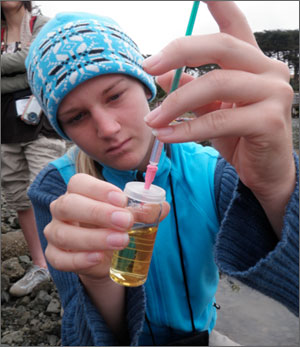 | | A student conducts water quality monitoring.
(NOAA National Marine Sanctuaries) |
|
In the year 2013 volunteers have spent more than 35,000 hours sharing what they know about national marine sanctuaries with the public. By answering questions, leading tours, and helping out at visitor centers, they promote not only conservation, but public awareness, and a respect for the sanctuary. Volunteers have also made contributions in the classroom, creating lesson plans and curriculum on things like ocean acidification, underwater mapping, coral growth, and shipwreck documentation The volunteers also engage in career outreach to students seeking higher education at academic institutions such as San Diego State University (SDSU), reaching hundreds of students and also faculty interested in opportunities or a future with NOAA.
Volunteers get Involved with Public Outreach Events
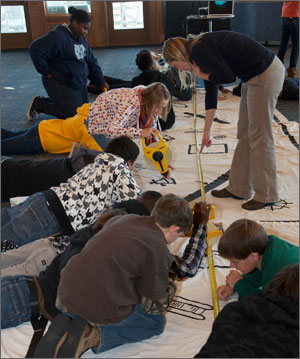 | | Students working on hands-on activities with a sanctuary volunteer. (NOAA National Marine Sanctuaries) |
|
Our volunteers attend many community outreach events including festivals, open houses and museum events to exhibit, host tables and educate the public about our sanctuaries. It is estimated that our volunteers have reached more than 400,000 people in one year at outreach events. One notable team of outreach volunteers in 2013 was the Outreach Team from Hawaiian Islands Humpback Whale. They participate in a broad spectrum of festivals and public events, such as the 9th Annual Honoli'i Pāka Aloha Honua Festival and Surfing Classic, sharing valuable information and volunteer opportunities. One of their most notable programs is the annual Ocean Count. In the past 17 years, more than 20,000 volunteers have contributed more than 100,000 hours of in-kind support.
Volunteers Collect Data for Citizen Science
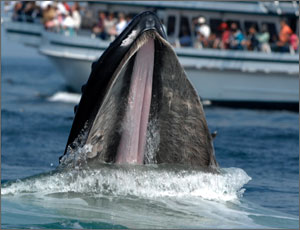 | | Whale watchers spot a whale feeding in Stellwagen Bank National Marine Sanctuary.
(NOAA National Marine Sanctuaries) |
|
Every day numerous volunteers are putting forth their time to participate in ONMS Citizen Science programs. Citizen Science programs engage volunteers in scientific study such as gathering important data on whale and seabird populations within the sanctuaries. This data is then used for scientific study and to help manage our sites. One program is the Coastal Observation And Seabird Survey Team (COASST), which is stationed in Olympic Coast National Marine Sanctuary. Volunteers locate and identify seabird carcasses that wash up on shore. These valuable statistics have created a baseline for beached bird mortality. Scientists can then use this data to monitor the bird population, and further explore the effects of a food shortage, oil spill, and weather among other things. In Stellwagen Bank and Channel Islands National Marine Sanctuaries, volunteers are using new marine mammal sightings apps, Spotter and Whale Alert, on local whale watching vessels to monitor the movement of whale populations, and the density of the populations. Information like this can help prevent future whale strikes by ships, and enables scientists to learn more about the patterns of these elusive mammals.
Students and Volunteers Spread Ocean Awareness Through Film
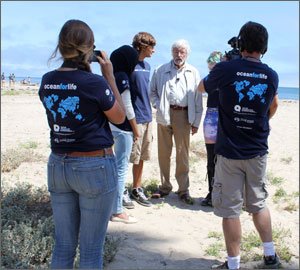 | | OFL participants interviewing and working along side Jean Michel Cousteau.(NOAA National Marine Sanctuaries) |
|
The 10th annual Gray's Reef National Marine Sanctuary Ocean Film Festival took place in Savannah, Georgia, September 20-23. For a decade, NOAA's Gray's Reef National Marine Sanctuary has been bringing ocean films to the people of the City of Savannah. The festival provides an opportunity to share inspiring ocean films with conservation messages with the public, increasing awareness of both the sanctuary and the ocean as a whole. The sanctuary welcomed renowned filmmakers and authors to Savannah for the festival, including Jean-Michel Cousteau, and honored the sanctuary Volunteer of the Year, Beau Mix, for his dedication in service of the sanctuary's education programs and workshops. This summer four film students volunteered to help with Ocean for Life, a multicultural program for high schools students from the United States and Middle East region. The film volunteers helped guide the students in the creation of media projects which summarized the two week long cultural and stewardship based program.
Volunteers Work in Shipwreck Reconnaissance
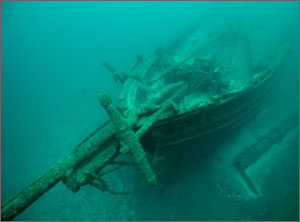 | | A close up view of the bow of the schooner FT Barney laying intact on the bottom of Lake Huron. (NOAA National Marine Sanctuaries) |
|
Information gathered by volunteers from the National Association of Black Scuba Diver, as well as SBNMS Maritime Archaeologists, and FKNMS Maritime Heritage staff, Sanctuaries has helped NOAA's Office of National Marine Sanctuaries to identify the remains of an early 20th century shipwreck in Florida Keys National Marine Sanctuary to be those of the 315-foot British steamship Hannah M. Bell which sunk in 1911. The field survey in late 2012 enabled sanctuary staff to confirm the wreck's origins. Similar to the way detectives use forensic information to solve a crime, sanctuary staff and volunteers compared the dimensions and construction characteristics of the shipwreck known locally as 'Mike's Wreck' with historic shipping records in order to solve this mystery. No lives were lost when the Hannah M. Bell grounded about six miles offshore of Key Largo, Florida, on April 4, 1911 loaded with coal bound for Vera Cruz, Mexico. Positively identifying a shipwreck enables residents and visitors to better appreciate Florida Keys maritime heritage, and provides charter dive businesses with an additional educational experience for their customers.
Volunteers Take to the Seas
Florida Keys National Marine Sanctuary's Team O.C.E.A.N. program directly engages with and provides educational information to boaters enjoying sanctuary waters. Interactions with the boating public were overwhelmingly positive this year, with most local boaters expressing gratitude for a program that provides an educational alternative to enforcement, and visiting boaters were appreciative for the helpful tips and free informational materials. Team O.C.E.A.N. provides on-the-water education and information aimed at protecting sanctuary resources while enriching the experiences of visitors to the Florida Keys. Team OCEAN volunteers also take to the waters in Monterey Bay, working to inform visitors of the important ecosystem they are visiting. Volunteers inform the public about the sanctuary and its special zones, encourage proper use of sanctuary resources, and provide tips on how to practice boating safety and reef etiquette. Informational packets are offered to vessels, including free charts, sanctuary brochures, and other helpful tips for navigating the sanctuary. Just this summer Team O.C.E.A.N. volunteers reached more than 700 boaters. Team O.C.E.A.N. helps protect sanctuary resources, but it also creates a positive dialogue and builds a relationship between NOAA and the local community.
College Students Find Alternative Ways to Help Out
 | | A University of Florida student on an alternative spring break in the Florida Keys National Marine Sanctuary pulls marine debris out of the water. (NOAA National Marine Sanctuaries) |
|
Fourteen volunteers from the University of North Carolina at Greensboro participated in a tiring but fulfilling alternative spring break at Grays Reef National Marine Sanctuary. The volunteers, a mix of students from a variety of majors, spent the week constructing props for an upcoming middle school underwater robotics competition the sanctuary hosts each spring. The devices the students built, crafted from PVC pipe, will simulate real-world underwater instruments during the competition. NOAA's Florida Keys National Marine Sanctuary hosted twelve college students for a more community service-oriented alternative Spring Break experience, during which they traded typical spring break revelry for gloves, bags and trash pickers as they conducted three days of marine debris cleanups on public lands encompassing three distinct habitats. Students also rescued a distressed loggerhead sea turtle, which was transported to The Turtle Hospital in Marathon, Florida for rehabilitation. Engaging volunteer students in activities such as these helps to promote not only ocean science education, but a lifelong interest in environmental stewardship, and valuable experiences to take with them into the working world.
Volunteers Take Out the Trash
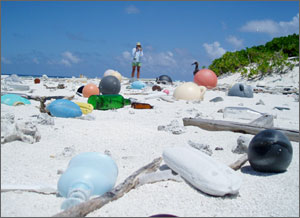 | | Marine Debris on Green Island at Kure Atoll State Wildlife Refuge in the Northwestern Hawaiian Islands Marine National Monument.
(NOAA National Marine Sanctuaries) |
|
It is estimated that over the past year, more than 2,500 volunteers have removed over 30 tons of trash from the coasts of National Marine sanctuaries, ranging from Maui to California, to the Gulf Coast, and the many places in between. Programs such as CoastSavers or Team OCEAN have helped make that possible by providing information, organization, and outreach in the communities. 15 tons of marine debris was removed from the coast line of Washington, including the shores of Olympic Coast National Marine Sanctuary. Marine debris is one of the most widespread pollution problems facing the world's ocean and waterways. Shoreline cleanup not only improves water quality, but also beautifies the areas the public enjoys so much, prevents the injury or death of marine life that could have become poisoned or entangled in the trash, and bring the community together for a common cause.
Volunteers Collect Information on the Humboldt Squid
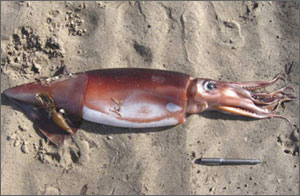 | | Humboldt squid have recently expanded their range northward from Baja and southern California, and periodically wash ashore on central California beaches.
(Photo: © Inger Marie) |
|
The Humboldt Squid, also known as the Jumbo Squid has a range that is rapidly expanding for the Baja area to Southern California and beyond. There creatures typically live most of their lives below 200 meters and move at very quick speeds, making them hard to observe and leaving us little information about them. That is where volunteers with the Beach COMBERS program at Monterey Bay National Marine Sanctuary come in. Beach COMBERS participants keep track of Humboldt Squid sightings, as well as gather statistics from the ones that periodically wash up on the coast. This valuable information has given scientists great insight into the feeding patterns of the Humboldt Squid, as well as enlightened them to the toxic algae blooms that are a probable cause for the mass numbers of squid that are dying and floating to the shore. The more we know about the Humboldt Squid, the more effective we can be in protecting them, and volunteers have made that all possible.
Volunteers Rack up the Hours
This year, volunteers contributed over 127,000 hours of their time to NOAA's Office of National Marine Sanctuaries. It was an increase of over 10,000 hours from the previous year!
Volunteers participated in thousands of different events and programs, and did it all out of a passion for the oceans and waterways that the Office of National Marine Sanctuaries protects. Among all the National Marine Sanctuaries, no volunteer effort was too small. From protecting our majestic whales from ship strikes, helping monitor seabird populations, cleaning debris, helping teach the next generation of stewards, or even just helping around the office, we appreciate everything they do.
|














